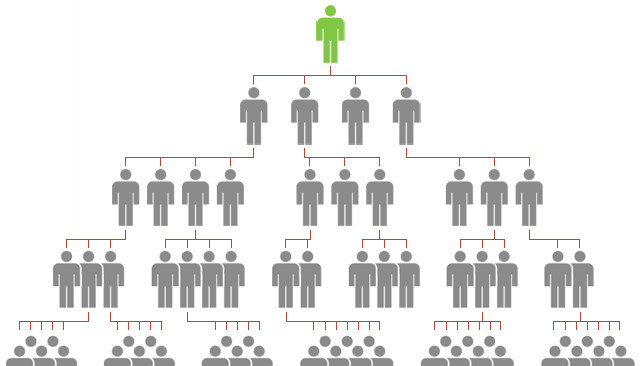MLM: Multi Level Marketing
MLM is an algorithm for “multi level marketing” also known as “pyramid schemes” and is also known as Network Marketing. It is not a type of business, but a way of doing business. MLM companies are not different than other companies who manufacture or distribute products in most respects. The key difference is in the way they advertise and distribute their products or services.

Instead of doing their own advertising and having their own in-house sales staff, multi level marketing companies pay independent distributors to sell products. Sales are based on the personal recommendation and endorsement of the distributor. But multilevel marketing is more than just direct sales. It takes direct sales one step further: they also pay distributor’s commissions on the sales of their own organizations simply by recruiting new distributors for the company. The distributor is then paid on the product sales made in their downline according to the company’s compensation plan.
Most multi level marketing compensation plans are based on a percentage payout for each level of distributors in a member’s downline (hence the term “multilevel”). When a distributor recruits new distributors for his or her down line, they are generally placed on the first level (or front line). When those distributors recruit, their new people are placed on their first level, which would be the second level of the first distributor. Most compensation plans pay a different percentage for each level down a specified number of levels.
Most network marketing pay plans also offer leadership incentives, such as extra percentages on lower levels, or even infinite levels, when some level of performance has been met, or they may have a bonus pool that is divided among high achievers according to some formula. Each company’s plan is a little bit different, so this is an important thing to evaluate when comparing companies (as well as products, the longevity of the company and other factors).
For those who are familiar with affiliate programs as they exist today on the internet, there is a lot of similarity between MLM multi-tiered affiliate programs that pay on more than one level. The difference is usually that in MLM Programs distributors buy a specified amount of product each month. Affiliate programs generally don’t require continuous sales to new customers in order to pay the affiliate a good commission check.
Multilevel marketing companies sell many different kinds of products and services. Some of the most popular products and services among companies are household products (e.g. Amway); vitamins and nutritional products (e.g. Shaklee & Herb life); cosmetics (Mary Kay Cosmetics & Avon) and discount long distances service (e.g. Excel Telecommunications).
In recent years, more and more established network marketing companies have been adding an internet presence. They have put up Websites describing their products and services and their business opportunity that allows online ordering and signing up as a distributor. Many provide websites for their distributors to use in their own marketing efforts. Click to read: Ten Mantras of Success
Critical Evaluation of Multi Level Marketing
Multi level Marketing is a cultural phenomenon, a method of marketing that has broken down the walls between commercial and private life. In other words it has commercialized our lives. It has distorted and poisoned some people’s relationships that previously were considered sacrosanct. MLM has a psychological grip on people. This grip is very strong and is periodically reinforced in the workshops and meetings conducted by MLM companies. In every meeting or workshop, multilevel marketing is introduced as a spiritual system. It is described as a non-competitive system of people helping each other, as opposed to individual, private acquisition. In other words, benefits accrue to each person to the degree that they help other people.

It is described as a new system for distributing income which breaks the cycle in which wealthy seem to get wealthier and the poor getting poorer. It is shown to be a way to achieve security and stability in job market outside the heartless ruthless corporate world. Further MLM companies try to convince the clients that not only do they offer quality, environment-friendly products but also offer them a business opportunity that will enable them to make quick money in their free time. But this is not true MLM system is inherently despairing and the only small number of people can ever succeed. A lot of people are wasting their time and losing money. The marketing system is so designed to convince the person who has been enrolled that, first, you can do it and then when you fail, and it convinces you that you failed only because of you. The failure is taken upon him by the individual. This perhaps explains why in spite of various limitations and inadequacies as a distributor concept Multi level Marketing is still popular.
MLM work by geometric expansion, where you get ten to sponsor ten and so on. This is usually shown as an expanding matrix with corresponding kick-backs at various levels. This implies at a mere three levels deep, that would be 1,000 people and the entire neighborhood is covered. At six levels deep, that would be 1,000,000 people believing that they can make money by selling. But this would mean entire city is covered. If it goes this way saturation is quickly likely to occur. But the MLM recruiters believe that not everyone will succeed so the market will never saturate. But this raises a crucial questions are we recruiting “winners” to build a real business or planning by design to profit of “losers” who buy into our confidence.
You may also like: How to increase sales?



Recent Comments